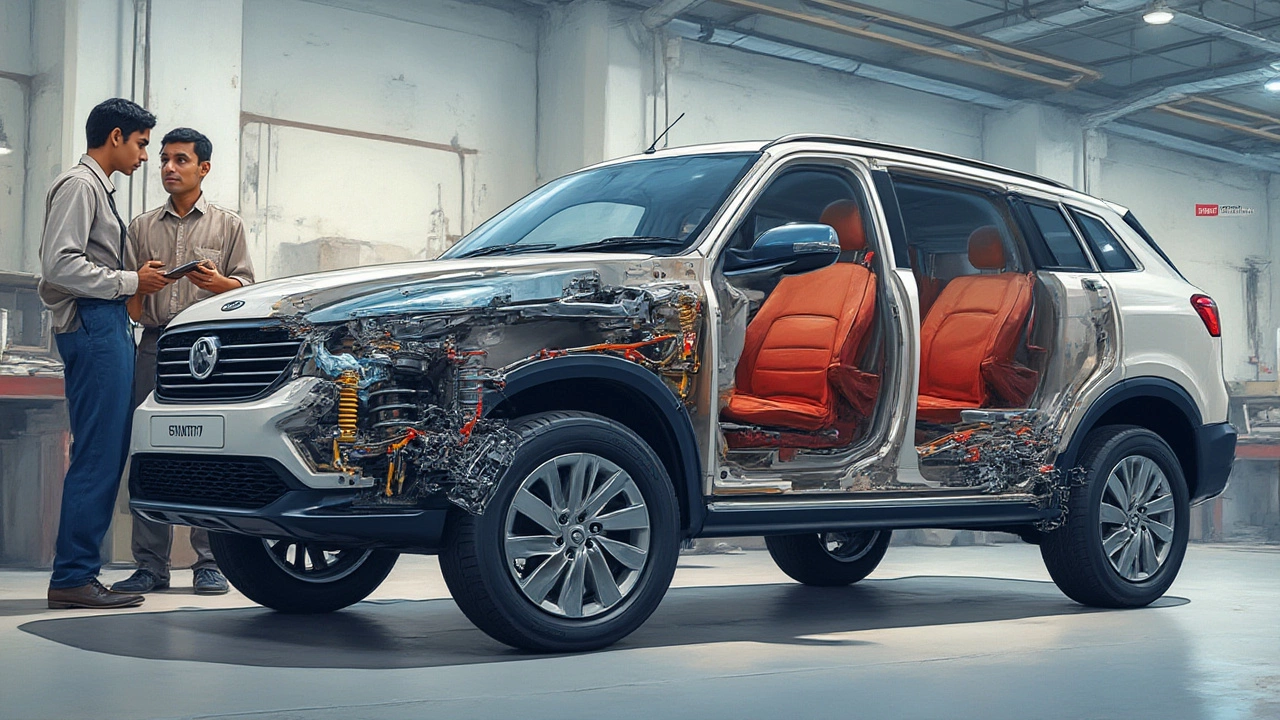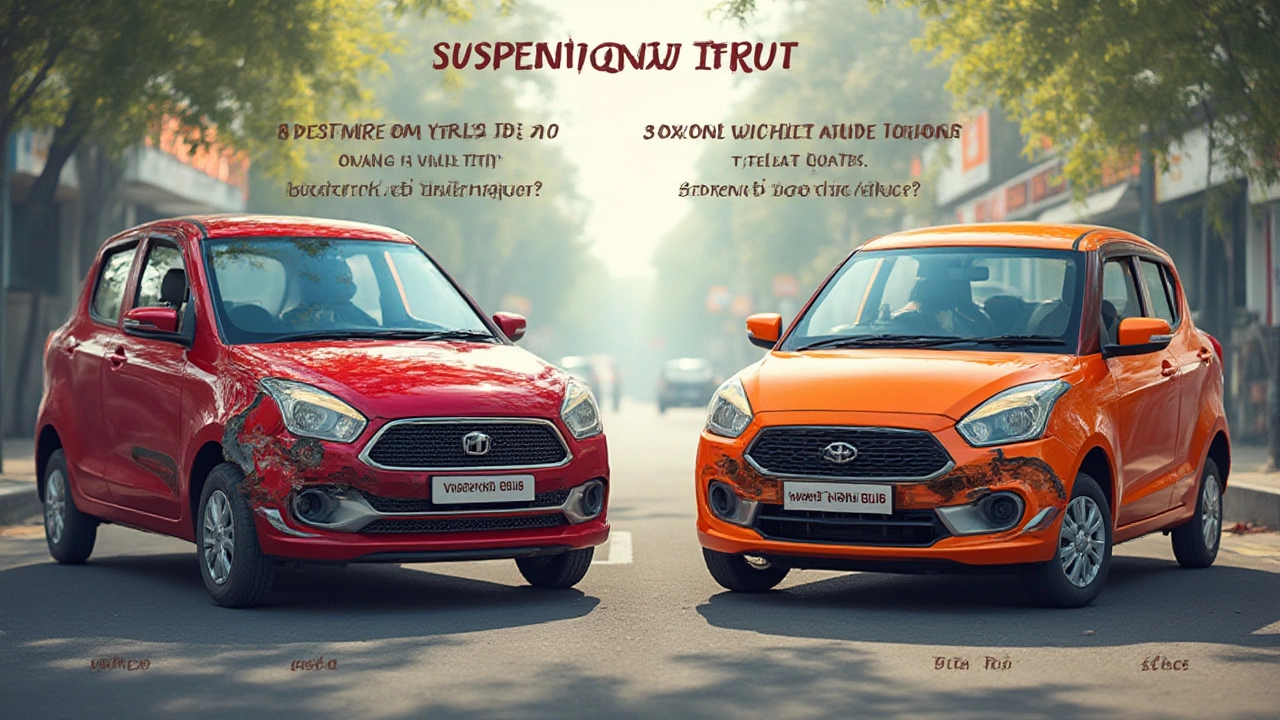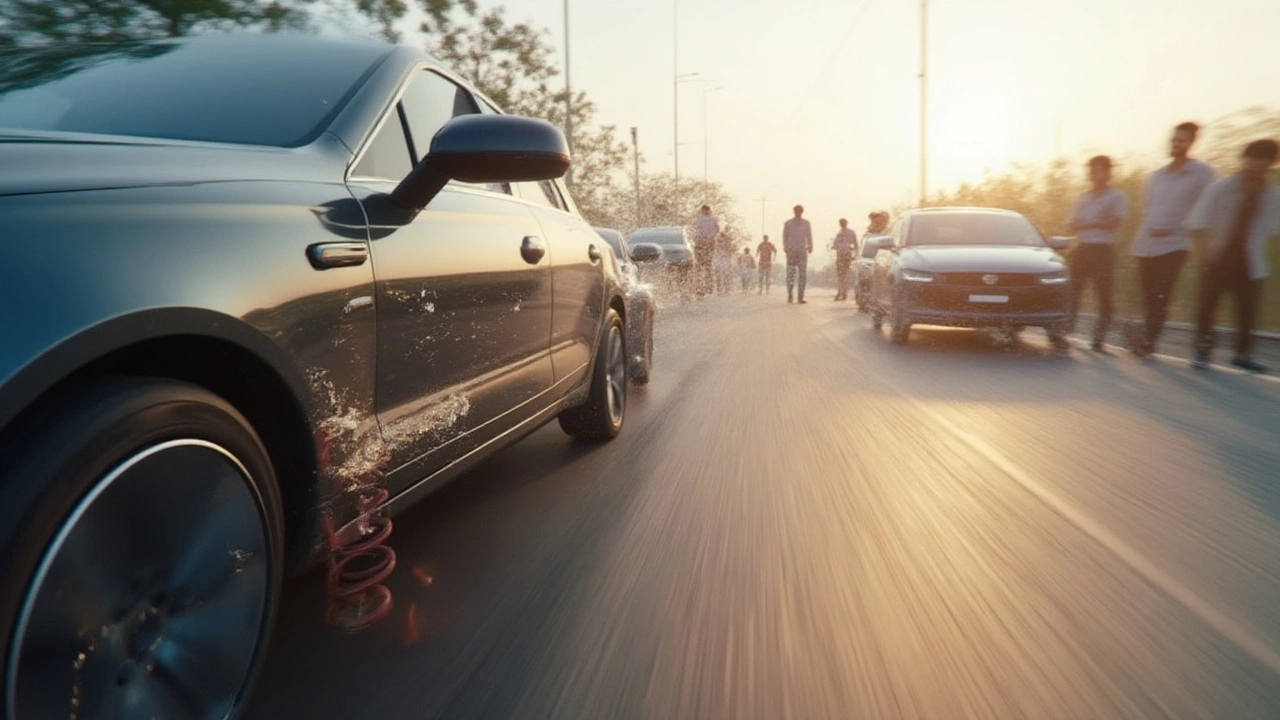 Jul, 22 2025
Jul, 22 2025
Suspension isn’t just a dull pile of springs and arms hiding under your car—it’s the unsung hero making sure bumps don’t send your coffee flying, corners don’t end in disaster, and your ride actually feels like, well, a ride. If you’re into cars, you've probably argued with someone about which front suspension system rules them all. Ask ten drivers, and you’ll get ten different answers. Why is there so much debate? Because front suspension isn’t a one-size-fits-all deal. Carmakers and mechanics obsess over every pivot and bushing—every little tweak can turn an ordinary pile of metal into something that hugs the road like glue, or a headache on four wheels. Here’s the thing: the best front suspension for you depends on where you drive, how you drive, and what you want from your car. Whether you’re into silky-smooth commutes or spirited canyon runs, knowing your suspension choices can change how you feel about hitting the road.
Popular Front Suspension Types Explained
The two names you’ll hear the most in the front suspension universe are MacPherson strut and double wishbone. These two designs dominate everything from tiny city cars to high-end sports sedans. But what’s actually happening underneath your feet, and why does it matter?
Let’s start with the MacPherson strut. If your car was built after 1980 and isn't sporting a premium badge, there’s a good chance you’ve got these up front. The MacPherson strut is famous for its simplicity. It marries the shock absorber and coil spring into a single upright unit, which bolts directly between your wheel and the car's body. It’s compact. It’s light. And for carmakers, it’s cheap to make—one big reason why it’s everywhere. Simplicity gives it a few perks: there’s more space under the hood, which means designers can squeeze bigger engines or more legroom. For small and midsize front-wheel-drive cars, it’s a practical choice. But there’s a catch. MacPherson struts don’t handle camber (that’s the angle the wheel leans at in a corner) perfectly, especially when pushed hard. So, if you hammer into corners like a rally driver, you might feel the tire scrubbing or hear the limits sooner.
Now, let’s talk about the double wishbone (sometimes called “A-arm”). Here’s where the engineering gets spicy. Instead of a single upright, double wishbone uses two arms—one up top, one below—which connect to the wheel hub. This setup lets engineers fine-tune exactly how the wheel moves during suspension travel. The result? Better camber control under hard cornering, more consistent tire contact, and a handling edge you’ll notice if you’re the sort who likes to “feel” every twist and turn. Because of its complexity and space requirements, double wishbone is more at home in performance cars and SUVs with room to spare. The Honda Accord, older BMWs, and sporty Mazdas have rocked double wishbone setups for years, giving them handling chops that go toe-to-toe with pricier machines. But it’s heavier, sometimes pricier to repair, and eats up more engine bay space.
There’s another system you’ll sometimes spot: the multi-link suspension. Think of it like double wishbone’s flexible cousin. Instead of two arms, you get three or more separate links, all working together. Engineers love it because it combines some of the MacPherson’s packaging benefits with double wishbone’s tuning potential. The downside? Multi-link is even more complicated, with more parts to wear out or go wonky over time. Audis, late-model Nissans, and luxury sedans love using multi-link at the front, and owners rave about the mix of comfort and grip.
Ever heard someone brag about torsion bar front suspension? These are rare in modern passenger vehicles, but not extinct—some trucks and rugged off-roaders still use torsion bars instead of coil springs, twisting to absorb bumps. The benefit is robust construction that can handle abuse, but they’re not winning any precision awards in the handling department. Still, for harsh conditions and hauling loads, some folks swear by them.
If you go way back, you’ll stumble on swing axles and kingpin setups, mostly in classic cars and old trucks. These systems are mostly museum pieces today—quirky but no match for the big three (MacPherson, double wishbone, multi-link) when it comes to modern ride and handling.
So, what’s the takeaway? Most cars balance costs, packaging, and expected use when picking a suspension setup. MacPherson is perfect for no-fuss, budget-friendly rides; double wishbone appeals to drivers after more control and feedback; multi-link is for those who demand both comfort and corner-carving, but are okay with extra maintenance down the road.

Real-World Strengths and Weaknesses
It’s easy to get lost in diagrams and engineering talk. What matters most is how these suspensions feel when you hit the road—or a pothole, or a mountain switchback. Real-world performance is where the rubber meets, well, the road.
Ride comfort is a biggie. Ever noticed how some cars glide over rough city streets while others react like you just rolled over a boulder? MacPherson strut setups usually offer a generous helping of comfort, especially at city speeds. It’s a forgiving system. Even if a strut mount gets tired, you won’t usually notice much drama right away. MacPherson’s built-in compliance (a fancy word for “give”) soaks up most urban imperfections. But there’s a caveat—hit a deep pothole, and you’ll know exactly what you ran over, since there’s less isolation than in multi-link or plush double wishbone setups. That’s why luxury cars with a focus on supreme comfort often look elsewhere.
Double wishbone shines when you get a little more spirited. Take a corner at speed, and this suspension keeps your tire flat against the pavement. That means less squeal, less understeer, and more planted confidence. Racers and track-day fanatics love double wishbone, which is why you’ll see it in everything from spec Miatas to million-dollar supercars. There’s a reason the Acura NSX, back in the '90s, used double wishbones—Honda’s engineers wanted nothing less than razor-sharp precision. This system can sometimes make a car feel a touch firmer or noisier on gnarly roads, though, especially if the bushings or ball joints wear out. And when it does come time for repair, expect a little more cost and complexity than your garden-variety strut swap.
Multi-link isn’t just a middle ground; it’s a chameleon. Picture a big Audi sedan floating down the highway at speed—it deadens bumps almost as well as air suspension but stays tight and composed in bends. That’s the magic of well-engineered multi-link: you can fine-tune each link for a perfect mix of soft ride and sharp steering. But, maintenance could become your nemesis. If just one bushing or link gets sloppy, the whole system can feel loose, or weird clunks creep in. Diagnosing the exact part that’s worn out? You might need a seasoned mechanic and a free afternoon.
Weather and load also mess with suspension choice. MacPherson and double wishbone handle wet or icy roads just fine, but if you live up a bumpy country lane or love camping trips, that’s where torsion bars or heavier-duty setups earn their keep. They aren’t elegant, but they don’t fail easily, shrugging off gravel, mud, and heavy gear loads alike. Ever wonder why you see so many old Toyota pickups still rolling on rough farm roads? Their tough old-school suspensions are practically immortal.
If you’re more into customization, maybe for tuning or off-roading, double wishbone and multi-link offer more room to tweak. Want more negative camber for your autocross car? No sweat with double wishbone—just ask any Miata or Civic track nut. Lowering a MacPherson car, on the other hand, takes more creativity if you want to avoid bad geometry or weird tire wear.
Reliability is another big factor drivers care about—a solid suspension should work without drama for years, right? MacPherson stands out for reliability due to fewer moving parts. Most drivers won’t even touch their front struts for 70,000 miles or more unless there’s a road salt issue or a big curb hit. Double wishbone and multi-link systems have more bushings, more control arms, meaning more chance for random squeaks or clunks as the miles rack up. If you hate chasing down small rattles, simple might be your friend.
Lastly, let's get practical with costs. Parts for MacPherson setups are usually the cheapest—shock, spring, and strut are all in one unit, making replacements straightforward. Double wishbone and multi-link? Plan on spending a bit more for specialized labor and pricier components. Luxury brands, in particular, might hit you hard if you ever need a suspension overhaul.

Tips for Choosing the Right Front Suspension
After all this, you might be wondering: which suspension should you actually look for when shopping or DIY modding? It boils down to your expectations and what you ask from your ride. Here are some practical checkpoints:
- Comfort or Handling? If you value comfort and predictability for daily driving, MacPherson strut is probably perfect. It’s the workhorse for commuters and family cars, soaking up bumps and keeping costs down.
- Performance Fan? Love winding roads and feedback through the wheel? Double wishbone or multi-link are calling your name. Look for vehicles that advertise “double wishbone” for the classic sports feel, or “multi-link” if you demand both grip and luxury.
- Driving Environment: Have to face broken roads, rough country lanes, or lots of snow? Trucks and SUVs with beefy suspension (including the rare torsion bar or solid axle) will serve you better than any delicate sport setup.
- Maintenance Are you a DIYer or prefer quick, cheap repairs? MacPherson makes life easier on the wallet and with less time on the jack stands. Lovers of double wishbone and multi-link, however, should brace for a tangled web of bushings, ball joints, and sometimes complicated alignments, especially as your car ages.
- Modification-Friendly: Dreaming of tweaking your car’s alignment, track width, or lowering it for style or performance? Double wishbone is far easier to play with, letting you dial in geometry for track work. MacPherson doesn’t take well to extreme drops without issues, so know your plans before tearing into things.
- Longevity: Simple usually means fewer headaches in the long run. That’s why plenty of Japanese economy cars from the '90s, loaded with MacPherson struts, are still rattling down highways decades later.
Obsessed with a specific car model? Do some digging. Look for user forums—owners love to share real-world suspension stories. It’s often there you’ll discover if a car’s fancy setup is a joy or a hassle after 100,000 miles. Brands like Toyota, Honda, and Mazda have built reputations on creating long-lasting, no-fuss suspension solutions, but even within a brand, setups can differ wildly depending on the year and trim. Watch out for models that switched from double wishbone to MacPherson or vice versa—car enthusiasts notice, and sometimes complain or cheer loudly about the difference.
If you’re getting your car serviced, don’t ignore suspension noises or alignment quirks. Sometimes, a simple bushing or ball joint swap can bring back that „new car“ tightness. But, if many joints are worn, or an accident has tweaked the frame, even the world’s fanciest suspension can’t work magic—sometimes, it’s time to move on to something fresher instead of battling endless repairs.
Here’s one more pro tip: don’t be dazzled by big, shiny components when tire shopping. Your choice of tire makes just as much difference in feel, comfort, and grip as the suspension itself. Spend on good rubber before chasing new coilovers or bushings. A decent tire can mask minor suspension flaws, while even the most advanced setup will feel terrible with cheap, hard, or old tires.
There’s no perfect front suspension for everyone. Your best setup depends on your driving style, needs, and—no shame here—your tolerance for weird rattles or repair bills. Take a test drive, quiz the dealer, crawl under a used car with a flashlight, and trust your gut. In the end, suspension is all about making the ride fit you, not the other way around.